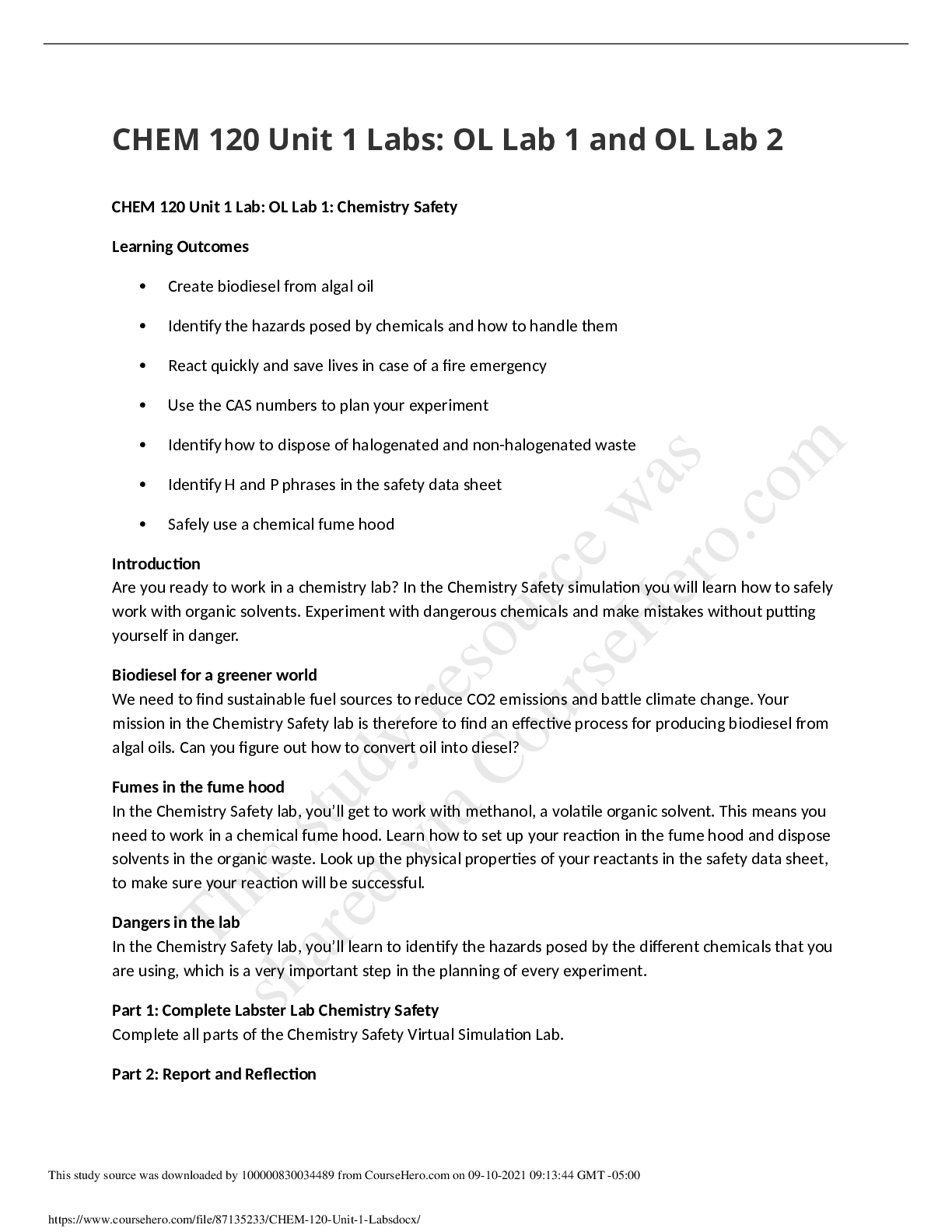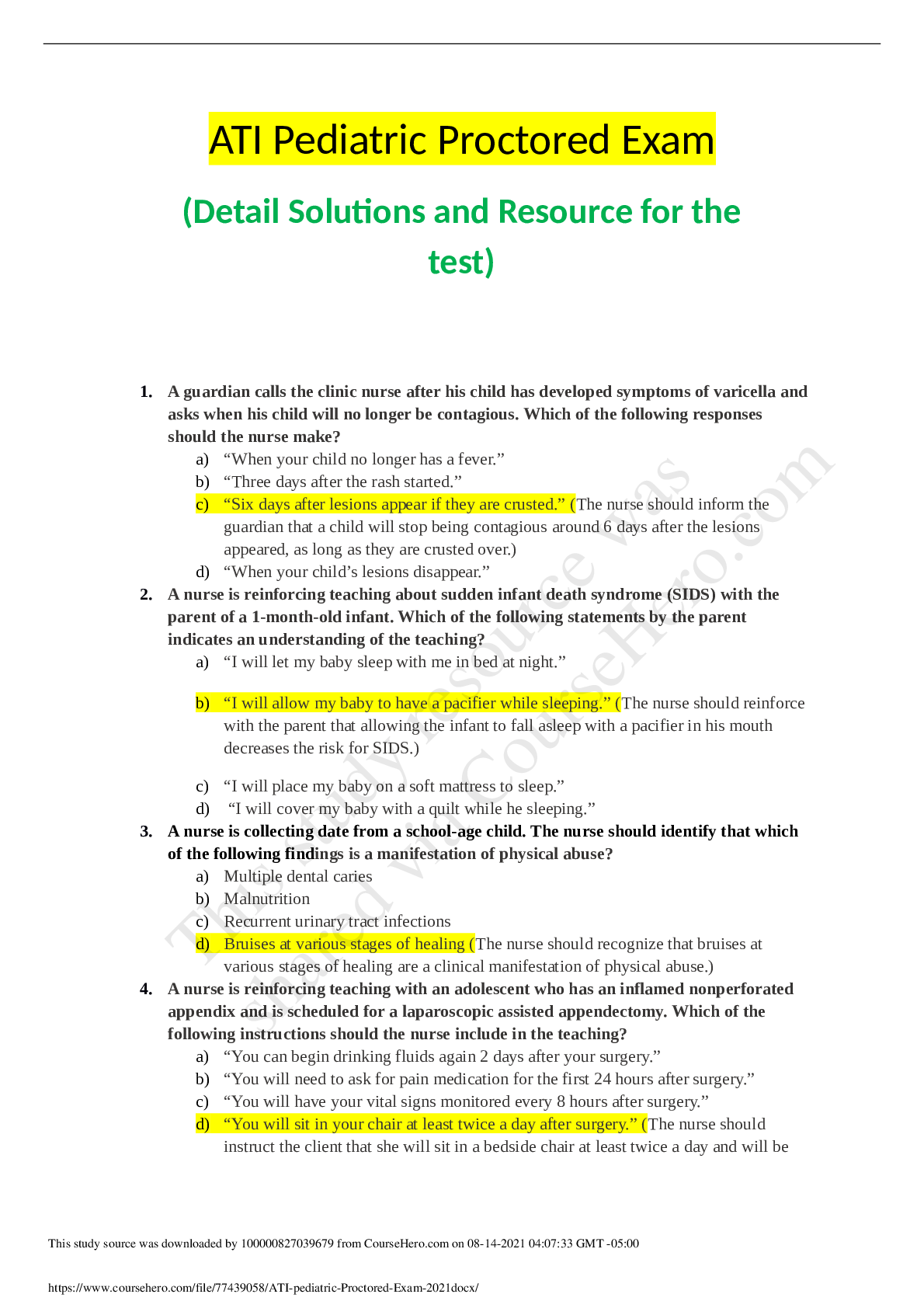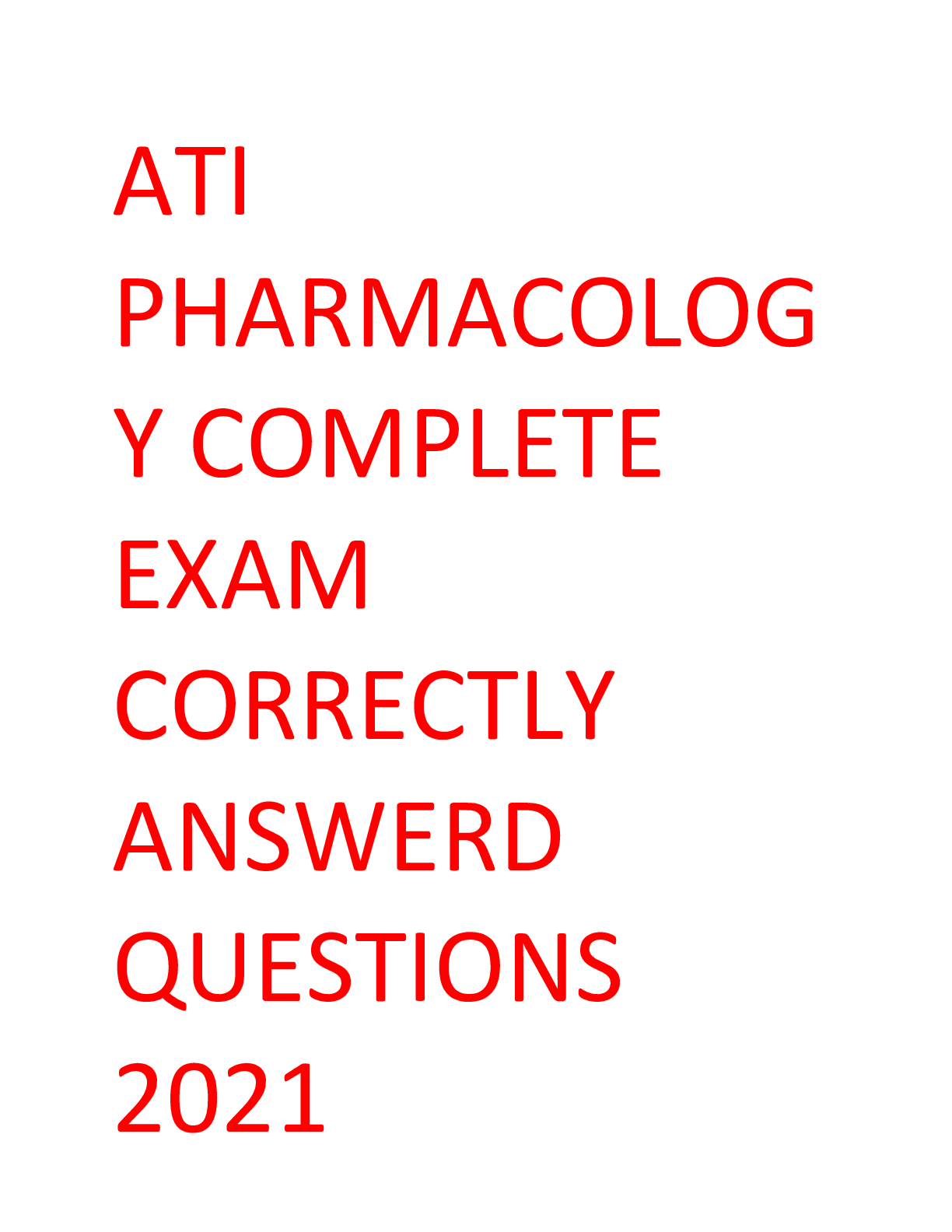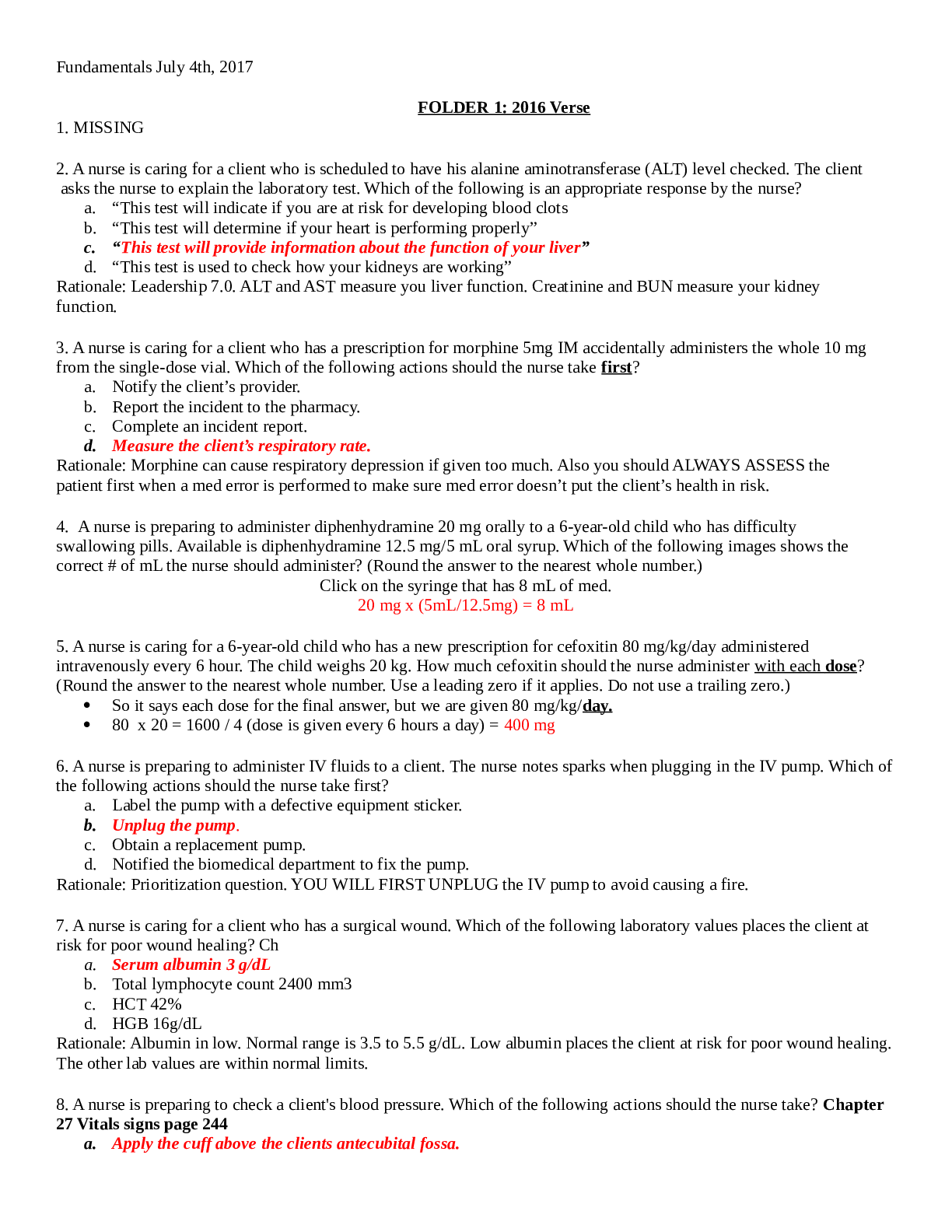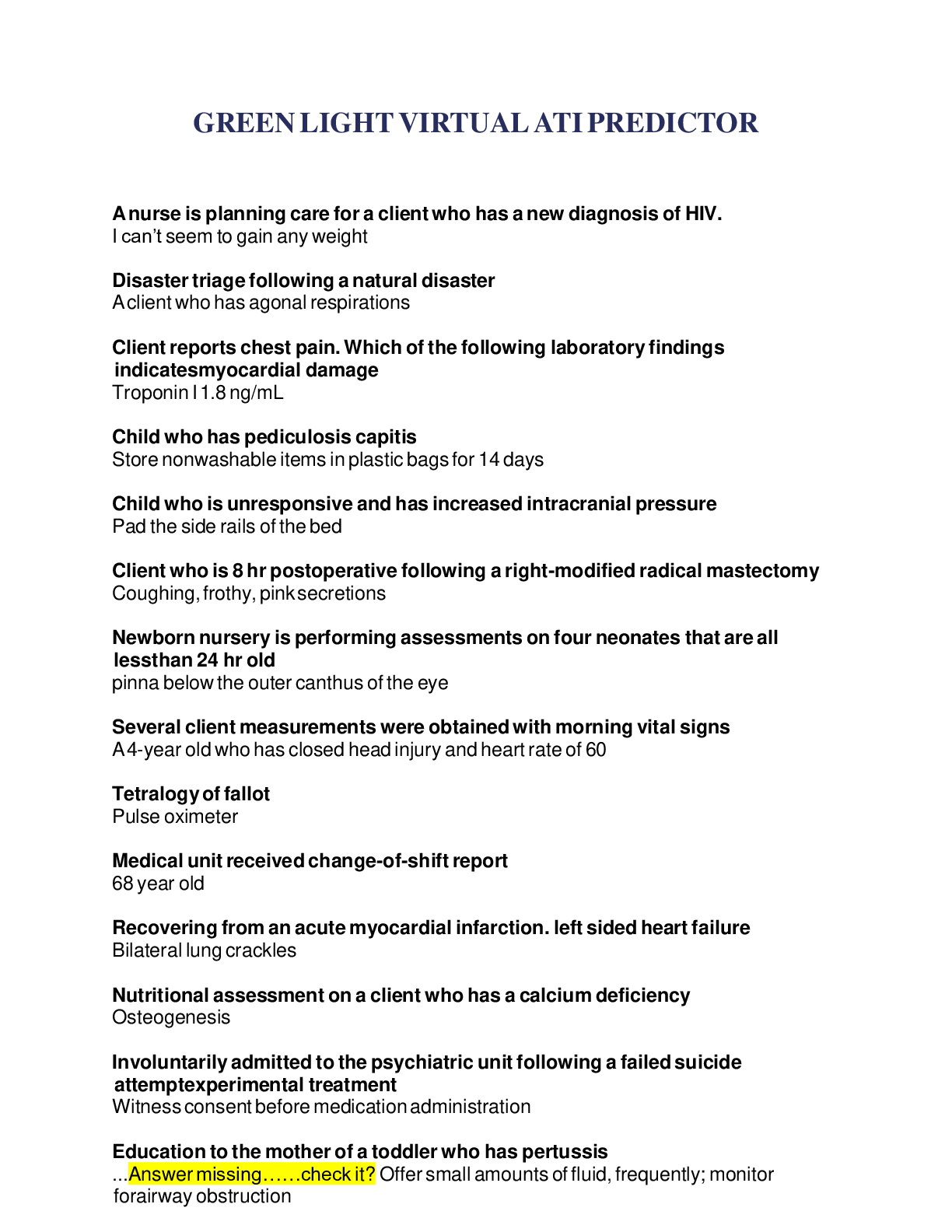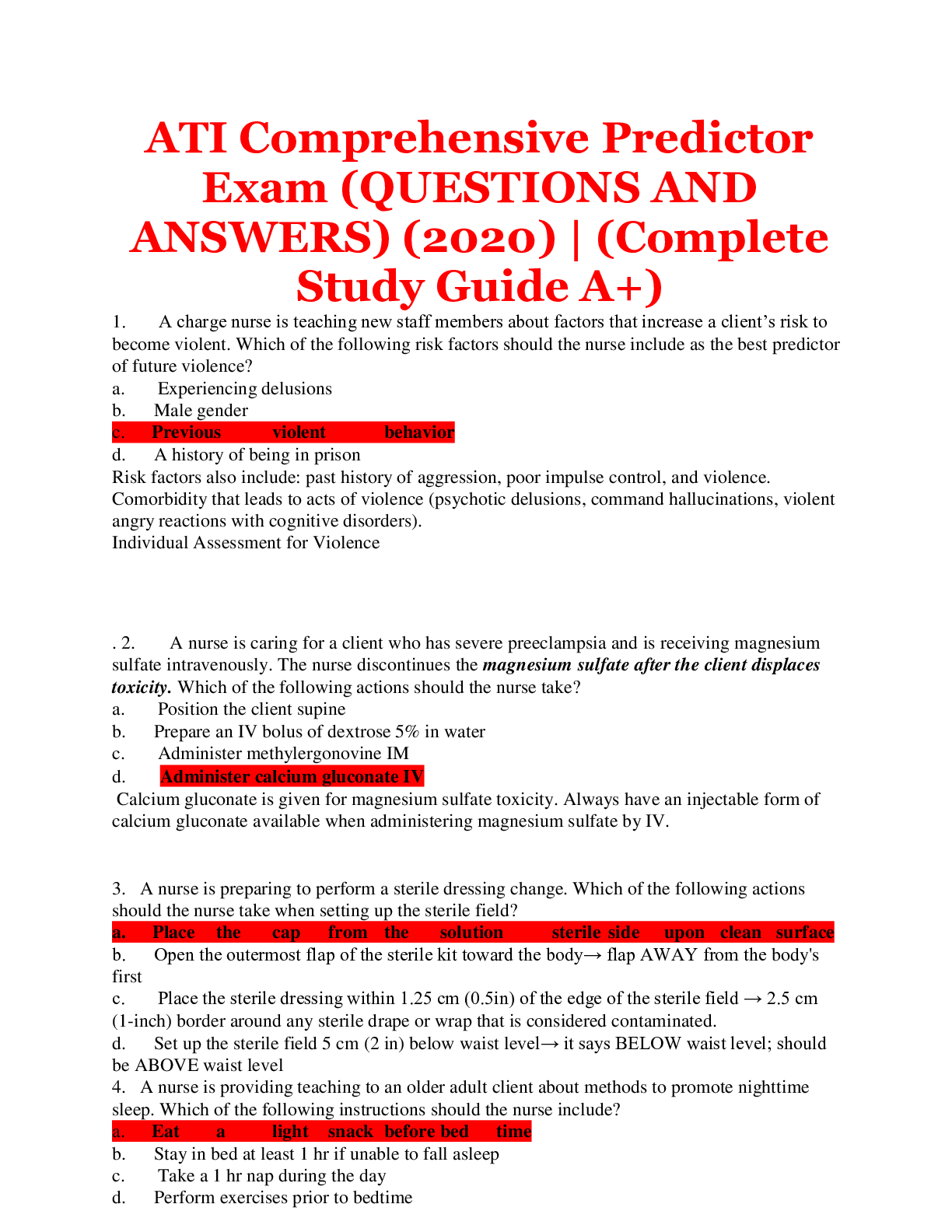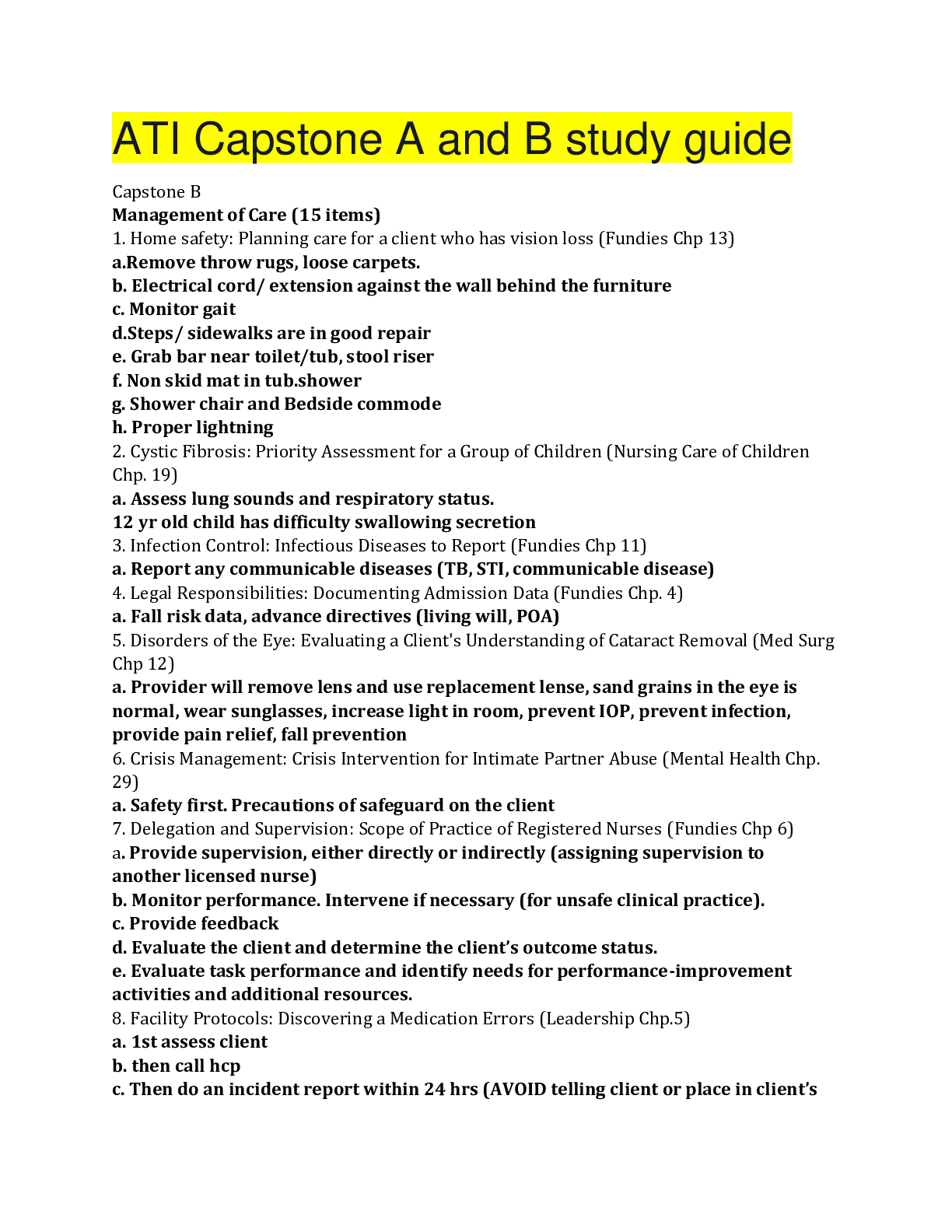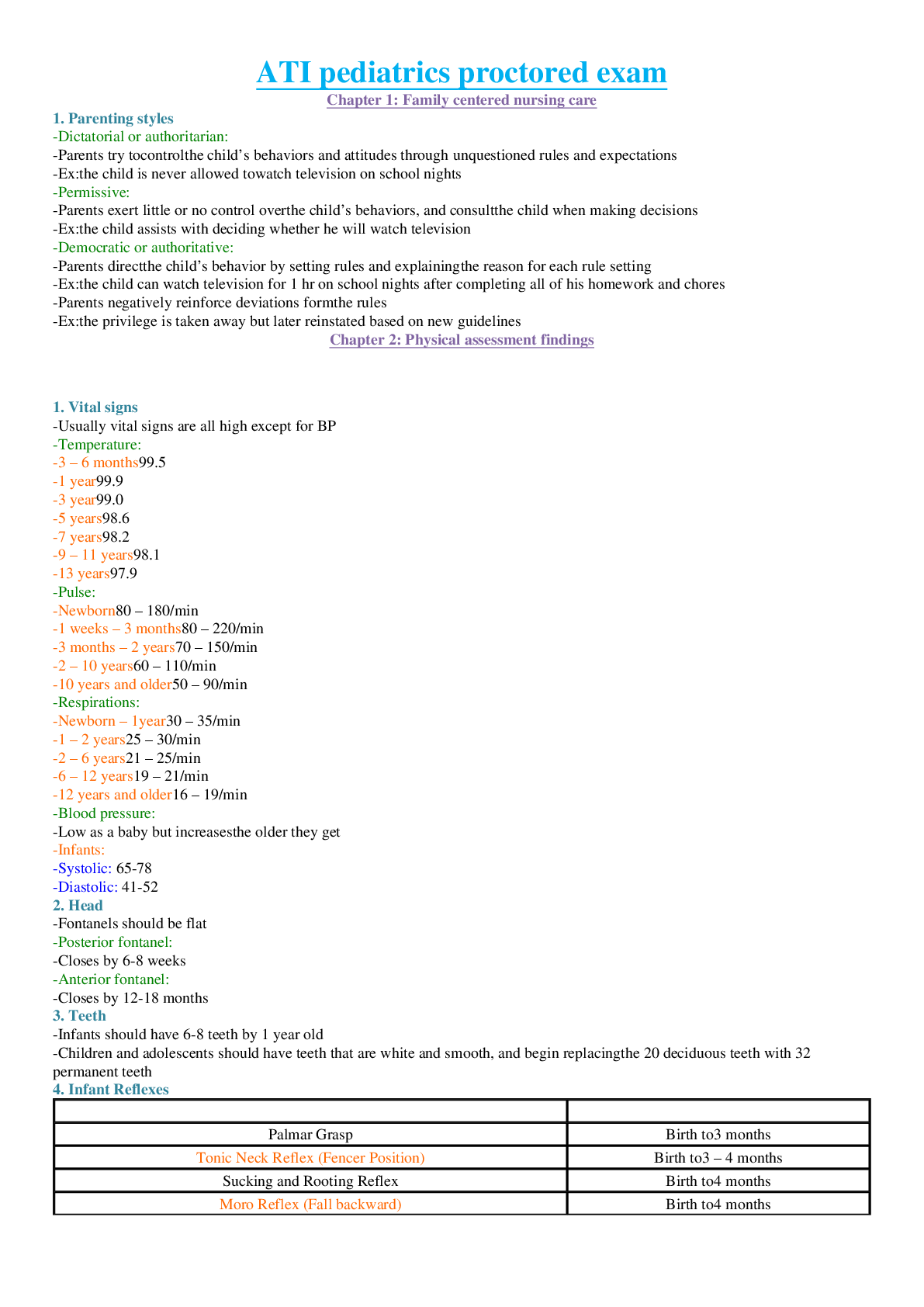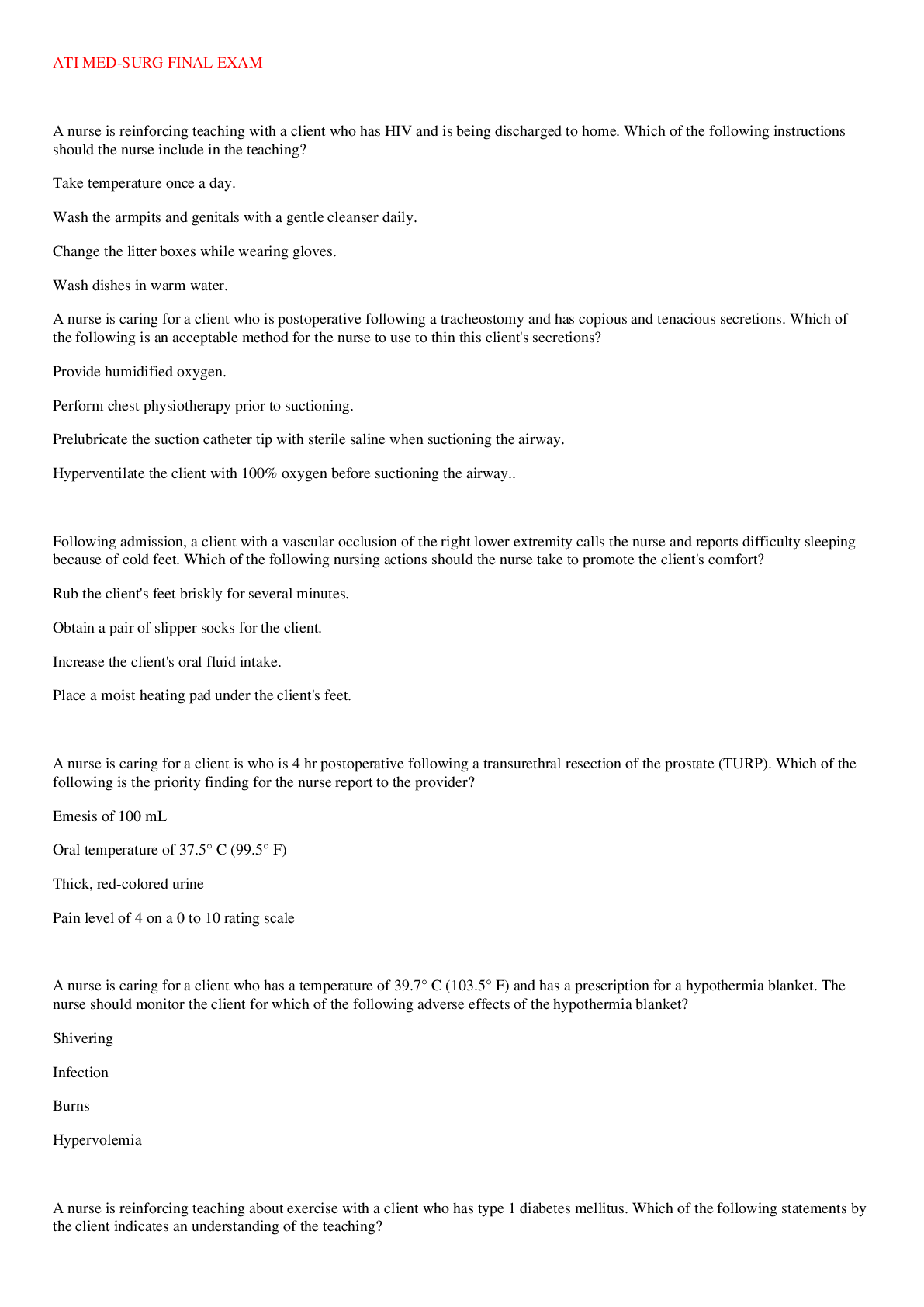*NURSING > QUESTIONS and ANSWERS > ATI COMPREHENSIVE 2021 C-ALL ANSWERS CORRECT-A COMPLETE GUIDE FOR EXAM PREPARATION-GRADED A+ (All)
ATI COMPREHENSIVE 2021 C-ALL ANSWERS CORRECT-A COMPLETE GUIDE FOR EXAM PREPARATION-GRADED A+
Document Content and Description Below
ATI COMPREHENSIVE C 1. A nurse is caring for a client who has bipolar disorder and is experiencing acute mania. The nurse obtained a verbal prescription for restraints. Which of the following should... the actions the nurse take? A. Request a renewal of the prescription every 8 hr. B. Check the client’s peripheral pulse rate every 30 min C. Obtain a prescription for restraint within 4 hr. D. Document the client’s condition every 15 minutes 2. A nursing planning care for a school-age child who is 4 hr postoperative following perforated appendicitis. Which of the following actions should the nurse include in the plan of care? a. Offer small amounts of clear liquids 6 hr following surgery (assess for gag reflex first) b. Give cromolyn nebulizer solution every 6 hr (for asthma) c. Apply a warm compress to the operative site every 4 hr d. Administer analgesics on a scheduled basis for the first 24 hr 3. A nurse is receiving change-of-shift report for a group of clients. Which of the following clients should the nurse plan to assess first? a. A client who has sinus arrhythmia and is receiving cardiac monitoring b. A client who has diabetes mellitus and a hemoglobin A1C of 6.8% c. A client who has epidural analgesia and weakness in the lower extremities d. A client who has a hip fracture and a new onset of tachypnea 4. A nurse is preparing to apply a transdermal nicotine patch for a client. Which of the following actions should the nurse tak e? a. Shave hairy areas of skin prior to application (apply to hairless, clean & dry areas to promote absorption; avoid oily or broken skin) b. Wear gloves to apply the patch to the client’s skin c. Apply the patch within 1 hr of removing it from the protective pouch (apply immediately) d. Remove the previous patch and place it in a tissue (fold patch in half with sticky sides pressed together) 5. A nurse has just received change-of-shift report for four clients. Which of the following clients should the nurse assess first? a. A client who was just given a glass of orange juice for a low blood glucose level b. A client who is schedule for a procedure in 1 hr (can wait) c. A client who has 100 mL fluid remaining in his IV bag (can wait) d. A client who received a pain medication 30 min ago for postoperative pain 6. A nurse is caring for a client who is receiving intermittent enteral tube feedings. Which of the following places the client at risk for aspiration? a. A history of gastroesophageal reflux disease b. Receiving a high osmolarity formula c. Sitting in a high-Fowler’s position during the feeding d. A residual of 65 mL 1hr postprandial 7. A nurse is reviewing the laboratory results for a client who has Cushing’s disease. The nurse should expect the client to have an increase in which of the following laboratory values? a. Serum glucose level- increased b. Serum calcium level-decreased c. Lymphocyte count- decreased immune system. d. Serum potassium level- decreased . 8. A nurse is caring for a client who has severe preeclampsia and is receiving magnesium sulfate intravenously. The nurse discontinues the magnesium sulfate after the client displaces toxicity. Which of the following actions should the nurse take? a. Position the client supine b. Prepare an IV bolus of dextrose 5% in water c. Administer methylergonovine IM d. Administer calcium gluconate IV Calcium gluconate is given for magnesium sulfate toxicity. Always have an injectable form of calcium gluconate available when administering magnesium sulfate by IV. 9. A charge nurse is teaching new staff members about factors that increase a client’s risk to become violent. Which of the following risk factors should the nurse include as the best predictor of future violence? a. Experiencing delusions b. Male gender c. Previous violent behavior d. A history of being in prison Risk factors also include: past history of aggression, poor impulse control, and violence. Comorbidity that leads to acts of violence (psychotic delusions, command hallucinations, violent angry reactions with cognitive disorders). Individual Assessment for Violence 10. A nurse is preparing to perform a sterile dressing change. Which of the following actions should the nurse take when setting up the sterile field? a. Place the cap from the solution sterile side up on clean surface b. Open the outermost flap of the sterile kit toward the body→ flap AWAY from the body's first c. Place the sterile dressing within 1.25 cm (0.5in) of the edge of the sterile field → 2.5 cm (1-inch) border around any sterile drape or wrap that is considered contaminated. d. Set up the sterile field 5 cm (2 in) below waist level→ it says BELOW waist level; should be ABOVE waist level 11. A nurse is providing teaching to an older adult client about methods to promote nighttime sleep. Which of the following instructions should the nurse include? a. Eat a light snack before bedtime b. Stay in bed at least 1 hr if unable to fall asleep c. Take a 1 hr nap during the day d. Perform exercises prior to bedtime 12. A home health nurse is preparing for an initial visit with an older adult client who lives alone. Which of the following actions should the nurse take first? a. Educate the client about current medical diagnosis b. Refer the client to a meal delivery program c. Identify environmental hazards in the homed. Arrange for client transportation to follow-up appointments Rationale Priority: Assess first. 13. A nurse is assessing the remote memory of an older adult client who has mild dementia. Which of the following questions should the nurse ask the client? a. “Can you tell me who visited you today?” b. “What high school did you graduate from c. “Can you list your current medications?” d. “What did you have for breakfast yesterday?” 14. A nurse is providing teaching to an adolescent who has type 1 diabetes mellitus. Which of the following goals should the nurse include in the teaching a. HbA1c level greater than 8%- 6.5 - 8 is the target reference. > b. Blood glucose level greater than 200 mg/dL at bedtime c. Blood glucose level less than 60 mg/dL before breakfast- < 70 = HYPOGLYCEMIC d. HbA1c level less than 7% 15. A nurse is caring for a client who is receiving phenytoin for management of grand mal seizures and has a new prescription for isoniazid and rifampin. Which of the following should the nurse conclude if the client develops ataxia and incoordination? a. The client is experiencing an adverse reaction to rifampin b. The client’s seizure disorder is no longer under control c. The client is showing evidence of phenytoin toxicity d. The client is having adverse effects due to combination antimicrobial therapy 16. A nurse is caring for a client who is 1 hr postoperative following rhinoplasty. Which of the following manifestations requires immediate action by the nurse? a. Increase in frequency of swallowing→ may indicate bleeding b. Moderate sanguineous drainage on the drip pad c. Bruising to the face→ side effect d. Absent gag reflex→ possibly due to anesthesia given. (1 hour postoperative) Rationale “Requires immediate action” choose the worst possibility that could lead to. ABC 17. A nurse is planning care for a preschool-age child who is in the acute phase Kawasaki disease. Which of the following interventions should the nurse include in the plan of care? a. Give scheduled doses of acetaminophen every 6 hr b. Monitor the child’s cardiac status c. Administer antibiotics via intermittent IV bolus for 24 hr d. Provide stimulation with children of the same age in the playroom 18. A nurse is planning an educational program for high school students about cigarette smoking. Which of the following potential consequences of smoking is most likely to discourage adolescents from using tobacco? a. Use of tobacco might lead to alcohol and drug abuse b. Smoking in adolescence increases the risk of developing lung cancer later in life c. Use of tobacco decreases the level of athletic ability d. Smoking in adolescence increases the risk of lifelong addiction 19. A nurse is assessing a client who is prescribed spironolactone. Which of the following laboratory values should the nurse monitor for this client? a. Total bilirubinb. Urine ketones c. Serum potassium- diuretic that retains potassium= hyperkalemic risk d. Platelet count Rationale ATI PDF p: 146 Pharm Complications: hyperkalemia 20. A nurse has agreed to serve as an interpreter for an older adult client who is assigned to another nurse. Which of the following statements by the nurse indicates an understanding of this role? a. “I will let the client know that I am available as the interpreter.” b. “I will receive a small fee for interpreting for this client.” c. “I am glad I’m available today, but when I’m not, you can use a family member.” d. “I will let the client know that an interpreter is unavailable during the night shift.” 21. A nurse is performing assessments on newborns in the nursery. Which of the following findings should the nurse report to the provider? a. A two day old newborn who has a respiratory rate of 70 --> 30 - 60 is normal b. A 16 hour old new newborn who has yet to pass meconium- you got 24 hours to pass stool c, A 2 day old newborn who has a small amount of blood tinged vaginal discharge d. A 16 hr old newborn whose blood glucose is 45 mg/dl- 40 - 60 is normal 22. A nurse on an acute unit has received change of shift report for 4 clients which of the following clients should the nurse assess first? Pain pallor pulselessness paresthesia a. A client who is 1 hr postoperative and has hypoactive bowel sounds b. A client who has fractured left tibia and pallor in the affected extremity c. A client who had a cardiac catheterization 3 hr ago and has 3+ pedal pulses d. A client who has a elevated AST level following administration of azithromycin 23. A nurse is providing discharge instructions to a client who has a new prescription for haloperidol which of the following adverse effects should the nurse instruct the client to report to the provider? a. Weight gain b. Dry mouth→ anticholinergic effects c. Sedation → s/s neuroleptic malignant syndrome??>> life threatening d. Shuffling gait →A/E EPS: is an indication of parkinsonism and should be reported to t 24. A nurse is planning discharge teaching about cord care for the parents of a newborn which of the following instructions should the nurse plan to include in the teaching? P . 177 ch 26 a. Clean the base of the cord with hydrogen peroxide daily- only with tub and sponge baths b. The cord stump will fall off in 5 days- about 10 - 14 days c. Contact the provider if the cord stump turns black d. Keep the cord stump dry until it falls off Rationale: cord usually falls out within 7 to 10 days. Clean with soap and water. Cord is expected to turn black and dry. [Show More]
Last updated: 1 year ago
Preview 1 out of 34 pages

Reviews( 0 )
Document information
Connected school, study & course
About the document
Uploaded On
Jun 25, 2021
Number of pages
34
Written in
Additional information
This document has been written for:
Uploaded
Jun 25, 2021
Downloads
0
Views
53

.png)





